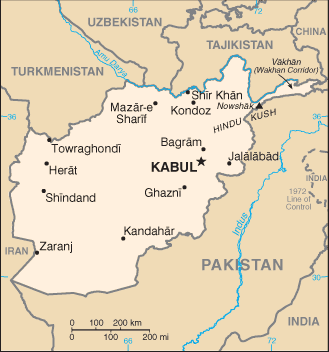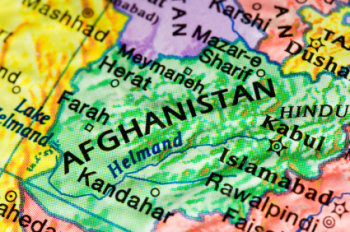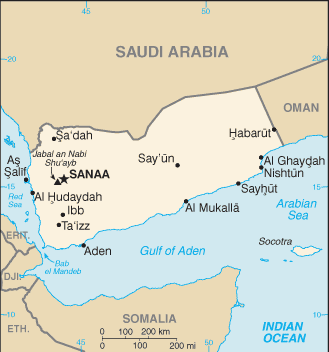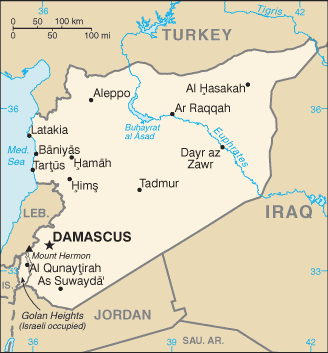Afghanistan.....
 The Pentagon won’t like that – they presented 10,000 troops as the “bare minimum” for Afghanistan repeatedly, and have been push for even bigger options for the residual force occupying Afghanistan from 2015 on.
The Pentagon won’t like that – they presented 10,000 troops as the “bare minimum” for Afghanistan repeatedly, and have been push for even bigger options for the residual force occupying Afghanistan from 2015 on.
 While that’s good news for Abdullah, his lead is not expected to get him over the 50 percent threshold, which means he and Ghani are still heading for a runoff vote some time in late May.
While that’s good news for Abdullah, his lead is not expected to get him over the 50 percent threshold, which means he and Ghani are still heading for a runoff vote some time in late May.
and....
 With so many of the attacks occurring against remote villages in the hills of Yemen’s rural interior, the death toll is difficult to ascertain, but at least 68 are believed to be dead over the past three days.
With so many of the attacks occurring against remote villages in the hills of Yemen’s rural interior, the death toll is difficult to ascertain, but at least 68 are believed to be dead over the past three days.
 The biggest strikes hit late Sunday in the Ferdous District, a marketplace district where 29 people, including several civilians, were killed in the air strikes according to rebels.
The biggest strikes hit late Sunday in the Ferdous District, a marketplace district where 29 people, including several civilians, were killed in the air strikes according to rebels.
 After yesterday’s attack, which killed 21, reports of today’s strikes are still murky, but at least 25 more were killed, sending the figure to 46, and likely to rise even further as the figures continue to come in from remote areas.
After yesterday’s attack, which killed 21, reports of today’s strikes are still murky, but at least 25 more were killed, sending the figure to 46, and likely to rise even further as the figures continue to come in from remote areas.

http://www.infowars.com/al-qaeda-in-syria-gets-manpads/
( The point here is the Rebels already have had manpads and anti- aircraft missiles for years and surely by now the stronger jihadist fighters have those weapons.... )
Report: US Considers Option for Less Than 10,000 Troops in Afghanistan
Pentagon Presented 10,000 Option as 'Bare Minimum'
by Jason Ditz, April 21, 2014
The latest reports from administration officials suggest that they are looking to the Pentagon to put together another option for them to consider for Afghan troop levels,one that is an “under 10,000″ option.
 The Pentagon won’t like that – they presented 10,000 troops as the “bare minimum” for Afghanistan repeatedly, and have been push for even bigger options for the residual force occupying Afghanistan from 2015 on.
The Pentagon won’t like that – they presented 10,000 troops as the “bare minimum” for Afghanistan repeatedly, and have been push for even bigger options for the residual force occupying Afghanistan from 2015 on.
Reports have emerged from time to time of lesser options, but they have all been shouted down by the Pentagon as far too little, and they continue to tell Congress that anything less than their envisioned residual force would see Afghanistan quickly crumble under Taliban offensives.
The latest report could well just be an exercise in pro-war rhetoric for the administration too, as they couched the lower option as being a result of how well they reckon the Afghan election went. Though the US hasn’t conceded it, Afghanistan’s Electoral Complaints Commission has documented even more corruption in this vote than the 2009 version, which saw millions of ballots thrown out.
Abdullah Widens Lead in Afghan Vote as Frontrunners Eye Runoff
Courting Other Candidates a Top Priority for Runoff
by Jason Ditz, April 20, 2014
The vote count for Afghanistan’s presidential election is now about half way through and Abdullah Abdullah’s lead is growing, at a strong 44.4% compared to runner-up Ashraf Ghani’s 33.2%.
 While that’s good news for Abdullah, his lead is not expected to get him over the 50 percent threshold, which means he and Ghani are still heading for a runoff vote some time in late May.
While that’s good news for Abdullah, his lead is not expected to get him over the 50 percent threshold, which means he and Ghani are still heading for a runoff vote some time in late May.
The politics of a run-off in the Afghan system change the strategy quite a bit, and Abdullah and Ghani, rather than running a second public campaign, are likely to focus primarily on winning endorsements from the six candidates that didn’t make it to the runoff, hoping their voters will follow the endorsement.
Of course, all of this coalition-building as a run-off tactic remains hypothetical, as Afghanistan has never seen a proper runoff. President Hamid Karzai won the first (heavily disputed) vote without a runoff, and while Abdullah and Karzai were set for a runoff in 2009′s (even more heavily disputed) vote, Abdullah withdrew before the vote, citing Karzai’s refusal to enact reforms to prevent fraud.
Iraq.....
Bombers, Clashes Leave 105 Dead, 127 Hurt Across Iraq
by Margaret Griffis, April 21, 2014
At least 105 people were killed and 127 more were wounded today when bombers struck deep into the Shi’ite south again. Baghdad also suffered from multiple bombing attacks. The now usual violence also occurred in Anbar and in the north.
In Anbar:
A battle in al-Jazira left nine militants dead and seven more wounded.
In Ramadi, a clash left six militants dead. Two police stations were blown up, but the number of casualties is unknown.
In Falluja, artillery fire killed two civilians and wounded five more. Six militants were killed.
Clashes took place in al-Siger. Fifteen militants were killed.
Elsewhere:
In Baghdad, a bomb killed two people and wounded nine more in the Shabbneighborhood. Three people were killed and 13 more were wounded when a suicide bomber struck a commercial area in Karrada. A roadside bomb in Shoala wounded five people.
A bomb in Sadr City killed five people and wounded 14 more.
A suicide car bomber killed 13 people and wounded 35 more, when he attacked aSuwayra police checkpoint. Civilians were among the dead.
A suicide car bomber at an army checkpoint in Madaen killed five people and wounded 12 more, including civilians and security personnel.
A clash at a Shirqat checkpoint left one soldier and five gunmen dead.
A bomb in Qadisiya killed a teacher and wounded four civilians.
A roadside bomb in Meshahda killed one soldier and wounded three more.
Gunmen killed one civilian and wounded two more in Latifiya.
A Sahwa member was shot dead in Baquba.
Gunmen in Hamrin killed a taxi driver.
A civilian was gunned down in Basra.
A dumped body was found in the Tigris River near Baiji.
A roadside bomb wounded three farmers in Udhaim.
Near Kirkuk, gunmen wounded a Kurdish Asayesh agent.
An I.E.D. wounded two farmers in Dujail.
Six militants were killed during a clash on a highway linking Amiriyat al-Fallujah withJurf al-Sakhar. A Saudi national who was also a militant leader was among them. This is a border area between Babel and Anbar provinces.
Nine militants were killed in Dwalibah.
In Mosul, a suicide bomber killed one soldier and wounded two more. Gunmen killed a soldier and wounded another at a checkpoint.
and....
Foreign Suicide Bombers Kill Thousands and Bring Iraq to the Brink of Civil War
Isis using Twitter to publicise nationalities of jihadists it has brought across Syrian border
A wave of suicide bombings carried out by foreign volunteers entering Iraq from Syria is killing some 1,000 civilians a month, bringing the country back to the brink of civil war. Many of the bombers are likely to have entered Syria across the 500-mile border with Turkey in the expectation that they would be giving their lives to overthrow Syrian President Bashar al-Assad and his government.
The foreign jihadists are brought to Iraq by the Islamic State of Iraq and the Levant (Isis), which in recent weeks has started to publicise on its Twitter feed the national origins of the bombers. According to a study by Bill Roggio, of the Long War Journal website, of 26 Isis bombers in one much-fought over Iraqi province, Diyala, north-east of Baghdad, no less than 24 were foreigners whose noms de guerre indicate that the majority came from North Africa, with 10 from Tunisia, five from Saudi Arabia, two each from Libya and Egypt, and one each from Denmark, Chechnya, Iran and Tajikistan.
Isis, which is seeking to establish an Islamic state in Iraq and Syria, does not recognise the border between the two countries. The bombers carried out their missions between September 2012 and today, but there has been a sharp escalation in bombings, usually aimed at killing as many Shia as possible, over the past year, with 9,571 civilians killed in 2013 and 3,630 killed so far in 2014.
The Iraqi government has for the first time become more open about which foreign states it holds responsible for supporting foreign jihadists fighting on its territory. In an interview last month with France 24 television, the Prime Minister, Nouri al-Maliki, directly accused Saudi Arabia and Qatar of being “primarily responsible for the sectarian, terrorist and security crisis in Iraq”. He said allegations that his government was marginalising the Sunni Arab community were made by “sectarians with ties to foreign agendas, with Saudi and Qatari incitement”.
Isis should have little problem transporting suicide bombers from Syria because it controls much of the north-east of the country, but their transit through Turkey in large numbers would require at least the passive consent of the Turkish forces. The Syrian government now controls almost all of its border with Lebanon, while Iraq’s other neighbours – Jordan, Saudi Arabia, Kuwait and Iran – tightly control their frontiers.
The Danish suicide bomber was identified by Isis as Abu Khattab al Dinmarki but, as with the other foreign jihadists, his real name was not revealed and his face was blurred in a picture. Isis is eager to publicise its pan-Islamic support, and two other of its units have also given details of their foreign volunteer bombers.
Isis has increased spectacularly in strength in Iraq over the past year. In March it staged a parade of vehicles, some of them military Humvees taken from security forces, in Fallujah.
The Iraqi government has recently evacuated the notorious Abu Ghraib prison, just west of the capital, which Isis stormed last summer, freeing hundreds of its militants. Iraqi government forces have not launched a counter-attack to retake Fallujah despite Isis filming the execution of 20 of its soldiers captured there.
Some 380,000 people have fled Anbar and other provinces to escape the surge in fighting, according to the UN High Commission for Refugees.
Yemen.....
At Least 68 Killed as US Drone Strikes on Yemen Enter Third Day
Death Toll Mounts, But Victims Remain Unnamed
by Jason Ditz, April 21, 2014
A barrage of US drone strikes across Yemen’s south and east has entered its third day today, and shows no signs of slowing down, as the latest US attacks targeted the Shabwa Province.
 With so many of the attacks occurring against remote villages in the hills of Yemen’s rural interior, the death toll is difficult to ascertain, but at least 68 are believed to be dead over the past three days.
With so many of the attacks occurring against remote villages in the hills of Yemen’s rural interior, the death toll is difficult to ascertain, but at least 68 are believed to be dead over the past three days.
Yemeni officials say the strikes are targeting “top leader” of al-Qaeda in the Arabian Peninsula (AQAP), and that they have high hopes they may kill one such leader, but they can’t confirm anything of the sort so far.
Indeed, while all of the official statements from Yemen have termed the slain “militants” or at the very least “suspects,” not a single person has been identified at all so far officially, and many civilians were confirmed among the slain on Saturday.
Air Strikes Kill 48, Including Civilians, in Syria’s Aleppo
Attacks Included Barrel Bomb Strikes Around City's South
by Jason Ditz, April 21, 2014
Multiple air strikes have pounded rebel-held areas in and around the northern Syrian city of Aleppo over the past 24 hours, killing at least 48 people and wounding dozens of others.
 The biggest strikes hit late Sunday in the Ferdous District, a marketplace district where 29 people, including several civilians, were killed in the air strikes according to rebels.
The biggest strikes hit late Sunday in the Ferdous District, a marketplace district where 29 people, including several civilians, were killed in the air strikes according to rebels.
Other attacks targeted the Baedeen neighborhood and Tlajabin, a village on the city’s outskirts, which were both attacked by barrel bombs from helicopters.
Barrel bombs have become increasingly notorious during the civil war for their inaccurate nature and powerful destructive potential. They amount to little more than an oil drum packed full of explosives and rolled out of a helicopter, and tend to careen out of control when the explosives start going off, sometimes taking out bystanders blocks away from the intended target.
At Least 46 Killed in Two Days of US Drone Strikes in Yemen
Most 'Suspects' But Some Confirmed Civilian Deaths
by Jason Ditz, April 20, 2014
Yesterday’s deadly US drone strike against a highway in Yemen’s Bayda Province was followed up by a similar round of separate strikes in the Shabwa Province today, sending the death tolls over the past 48 hours spiraling.
 After yesterday’s attack, which killed 21, reports of today’s strikes are still murky, but at least 25 more were killed, sending the figure to 46, and likely to rise even further as the figures continue to come in from remote areas.
After yesterday’s attack, which killed 21, reports of today’s strikes are still murky, but at least 25 more were killed, sending the figure to 46, and likely to rise even further as the figures continue to come in from remote areas.
Officially, the Yemeni government referred to the slain today as “leading and dangerous” al-Qaeda figures, but tellingly offered not a single name of a single victim of the attacks.
While today’s victims remain a mystery, a number of civilian bystanders were confirmed killed in yesterday’s attack, which targeted a truckload of “suspects” and destroyed some nearby cars.
Syria.....
France backs claims that Syrian forces have used chemical weapons recently
François Hollande says France has 'information' that toxic gases have been used against opposition in recent attacks

A woman, affected by what activists say was a gas attack, breathes through an oxygen mask at a field hospital in Kfar Zeita, Syria. Photograph: Reuters
Allegations that Bashar al-Assad's forces used chemical weapons in recent attacks gained traction on Sunday when France said it had "information" of toxic gases being used against opposition targets.
The claim, by the French president, François Hollande, follows accusations by the exiled Syrian opposition and rebel groups in the west and south of the country that gas has been used nine times in the past two months, killing more than 10 people and affecting hundreds more.
Hollande was not specific about the basis for his claims, which he said had not been proved. However, France has remained in close contact with opposition leaders and previously used its own government laboratories to verify that sarin had been used in a mass attack near Damascus last August.
The French leader told Europe Radio 1 that whatever had taken place was "much less significant than those in Damascus … but very deadly".
France, the US and Britain vehemently blamed the Syrian regime for that attack, which killed between 355 and 1,400 people in rebel-held suburbs of the capital and led Barack Obama to threaten a military strike against Assad.
At the time, each government based its assessments on signals intelligence, which tracked rocket launches on the night of the attack, as well as intercepts of frantic conversations between field commanders and senior officials in the immediate aftermath.
The Organisation for the Prohibition of Chemical Weapons (OPCW) was tasked with removing Syria's chemical weapons arsenal, which Assad surrendered in a deal brokered by Russia to avoid being bombed. It later found that samples taken from where the rockets landed matched those of the regime's supply of sarin.
The OPCW last week said 80% of Syria's chemical weapons had so far been handed over for destruction. The organisation told the Guardian recently that it would not investigate the new claims unless they were referred to it by a signatory state.
Syria has acknowledged that casualties in at least two recent attacks showed symptoms of being gassed. However, as was the case in the mass chemical strike, it blamed the al-Qaida-aligned rebel group Jabhat al-Nusra.
The Syrian National Coalition called for an international investigation after the most recent incident. It said samples of blood and clothing from people reporting symptoms of gassing had been transferred to Turkey for analysis. It also said it had passed on information to the United Nations and the OPCW.
Before the mass chemical weapons strike, opposition groups in frontline areas of Damascus had regularly alleged that fighters and citizens were dying of gas-like symptoms. The precise substance was never identified. However, British and US officials believed a diluted form of sarin, or industrial strength pesticides and chemicals such as chlorine, were likely culprits.
Residents of areas struck in recent months have reported a strong smell of a chlorine-like substance. In two cases they recorded video of a large bomb dropped from a helicopter exploding as it hit the ground and emitting a large grey cloud that was deemed to be unusual. Residents reported symptoms of nausea and respiratory distress in the hours afterwards.
Israeli defence officials also said this month they believed chemicals had been used in a recent attack near Damascus. However, they offered no details.
Pressed on what he could add, Hollande said: "What I do know is what we have seen from this regime is the horrific methods it is capable of using and the rejection of any political transition."
Assad made a rare public appearance on Sunday in the Christian town of Maaloula, which was captured from rebels last week. One returning resident told Reuters the village had been destroyed in the fighting. "The houses are totally destroyed, the whole village was destroyed. I can't describe the amount of damage to the village," said the villager, who gave her name as Lorain.
( The point here is the Rebels already have had manpads and anti- aircraft missiles for years and surely by now the stronger jihadist fighters have those weapons.... )
Al-Qaeda in Syria Gets Anti-aircraft Missiles
Obama admin. floats PR campaign for weapons sent years ago
Kurt Nimmo
Infowars.com
April 21, 2014
Infowars.com
April 21, 2014
Time reported Monday officials at the White House are seriously considering sending manpads – man-portable air defense systems – to terrorist mercenary groups operating in Syria. Discussion is reportedly underway, but “strong doubts remain about the wisdom of providing missiles to the rebels.”
Syrian mercenaries use Manpad in July, 2013.
Earlier this month, we reported the United States delivered its sophisticated BGM-71 TOW anti-tank weapon to “moderate” mercenary forces in Syria.
Islamists in Syria, aka al-Qaeda and its al-Nusra affiliate, now dominate the proxy war against Bashar al-Assad. “The moderates, often underfunded, fragmented and chaotic, appear no match for Islamist units, which include fighters from organizations designated ‘terrorist’ by the United States,” Reutersreported last June.
In late March, Obama floated the idea of sending the advanced anti-aircraft system. He also reassured the Saudis, who are the primary benefactors of the mercenaries attempting to overthrow the Syrian government, the United States has not abandoned the effort to arm al-Qaeda and other fanatical Islamic groups.
“The introduction of manpads could be a game-changer in Syria, like it was in Afghanistan in the 1980s with Stinger missiles,” an Arab official told Time.
Stinger missiles would eventually be used against the United States military in Afghanistan. In 2007, the Pentagon covered up a reported surface-to-air missile strike by the Taliban that shot down a Chinook helicopter over Helmand, killing seven soldiers.
“The war logs detail at least 10 near-misses by missiles in four years against coalition aircraft, one while refueling at 11,000ft and another involving a suspected Stinger missile of the kind supplied by the CIA to Afghan rebels in the 1980s,” The Guardian reported in 2010.
The latest “discussions” and reservations on the part of the intelligence community cited by Time are nothing more than a calculated public relations campaign for a fait accompli.
On September 14, 2012, three days after ambassador Chris Stevens was murdered in Benghazi, Libya, Sheera Frenkel, a correspondent for the Times of London, reported from Antakya, Turkey that a “Libyan ship carrying the largest consignment of weapons for Syria since the uprising began has docked in Turkey and most of its cargo is making its way to rebels on the front lines.”
Frenkel reported that “more than 400 tonnes of cargo the vessel was carrying were SAM-7 surface-to-air anti-aircraft missiles and rocket-propelled grenades (RPGs), which Syrian sources said could be a game-changer for the rebels.”
It is now known that Stevens was working with the CIA in Benghazi to siphon weapons through Turkey to al-Qaeda and other mercenaries in Syria.
Investigative journalist Seymour Hersh reported on April 17 that for “months there had been acute concern among senior military leaders and the intelligence community about the role in the war of Syria’s neighbors, especially Turkey. Prime Minister Recep Erdoğan was known to be supporting the al-Nusra Front, a jihadist faction among the rebel opposition, as well as other Islamist rebel groups.”







No comments:
Post a Comment